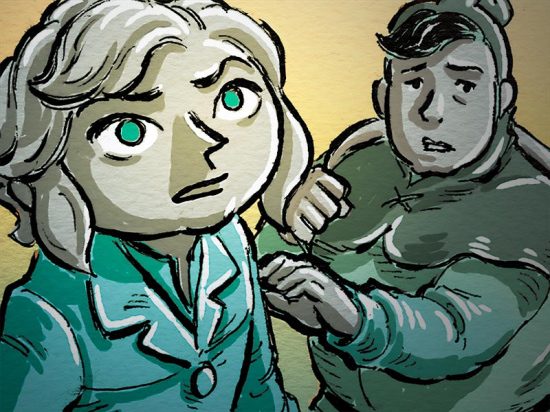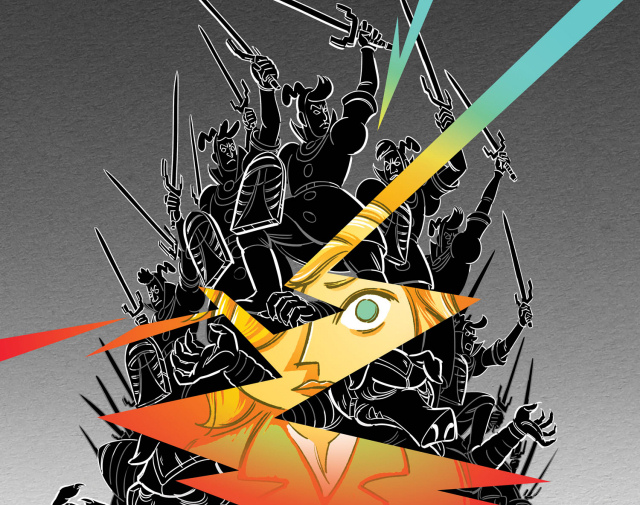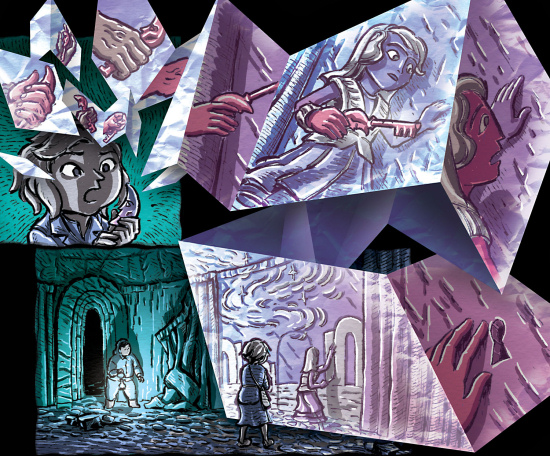At the heart of the new graphic novella Second Quest is a question: “What would it be like to be Zelda?”
That’s a question that writer Tevis Thompson and artist David Hellman (you know him from Braid) asked themselves when they started creating Second Quest. The idea came from an essay Thompson wrote called “Saving Zelda,” a criticism of Nintendo’s popular The Legend of Zelda video game series. Second Quest—a story about a young woman and “non-princess” who suspects the legends of her island home in the sky aren’t true—caught on with over 1,500 backers on Kickstarter in 2012 and earned more than $69,000 in support.
Like “Saving Zelda,” it’s not a love letter to the series. It asks for more.
Looking skyward

The setting of Second Quest—a floating island in the sky where we meet the protagonist, Azalea—is a clear reference to Skyward Sword, the Zelda game for Wii that launched a year before Thompson wrote his essay. “It’s what we were both responding to at first, and chronologically, it is the origin story for the Zelda universe—which makes it feel particularly important, the primal pattern for its own mythology,” Thompson told me.
“[Princess Zelda] starts out as this real, believable girl but very soon gets drawn into her ‘destiny’ and loses all character and agency. She’s inducted into a goddess cult, revealed to be the goddess herself, and imprisoned by her duty. She even apologizes to Link for manipulating him into saving the world!”
Thompson and Hellman traced more problems back to previous games, including the original The Legend of Zelda on the Nintendo Entertainment System (NES).
“And we expanded from there into the broader world of games and gaming culture,” Thompson said. “Actually, the broader world in general. Gaming problems are human problems, and we wanted our story to speak to more than just Zelda fans and longtime gamers—though them, too.”
The missing woman

In Second Quest, Azalea dares to break the rules and sneaks outside the city limits, venturing close to “the edge” of the island. She searches ruins for clues from the past and starts experiencing visions that cause her to doubt society’s teachings and laws. That gets her into trouble and triggers an unsettling series of events that forces her to make a life-changing decision.
Unlike Zelda, Azalea is not a princess. But people still try to save her as if she were one.
“It’s not so much a question of whether a princess—or anyone—needs to be saved/protected,” Thompson said. “It’s that no one ever asks the princess what she wants to begin with. It’s really a question of agency and subjectivity. Who gets to act? Whose subjectivity matters?”
Those are questions that rarely, if ever, get asked of Princess Zelda. “She waits or sleeps or hibernates in a crystal while Link runs around,” he said. “At the end of the first Zelda, you find her locked in a room deep underground, with just two flames to keep her company. This image has stayed with me since I first encountered it in 1987, and it found its way into Second Quest, too. All these years I’ve wondered: What was she doing in that room for so long? What was she thinking? When the door finally opened, how did she feel?
“There’s a missing woman at the heart of the Zelda series. And not just captured, imprisoned, needing to be saved, but fundamentally absent. Even when she gets to act as Sheik, she’s essentially just a masked ninja, a type defined by being hidden. The legend of the title is quite right. That’s all Zelda is—a legend.”
“There are islands everywhere”

Though you can draw a clear line between Second Quest and The Legend of Zelda, Thompson and Hellman weren’t interested in packing the comic full of gaming Easter eggs. They wanted Second Quest to resonate with readers unfamiliar with Zelda as well.
“We’re working in fantasy here, and the language of fantasy is fundamentally metaphoric,” Thompson said. “It’s not that everything simply means something else, like a symbol or code. It’s that we understand fantasy stories with the deeply associative parts of our brain.”
The island where Azalea lives, for example, can be interpreted in a broad sense. As Thompson said, gaming problems are human problems.
“While writing Second Quest, I was thinking a lot about island cultures, island mentalities,” he said. “I’d spent four years in China just prior and was thinking about the ways censorship isolated my students, about the terrible things that happened in modern Chinese society when it closed itself off from the world. But then I came back to the United States and saw more clearly all the ways Americans isolate themselves, too, from the world and each other. That fear of difference, of uncertainty, of ‘others.’
“This is what I mean when I say Second Quest is not only about Zelda or insular gamer culture. There are islands everywhere.”
The legends of Zelda
Thinking about Zelda metaphorically encouraged Thompson and Hellman to piece apart “the logic of Zelda” and figure out how to express it through the artwork. “Even David’s panel layouts for each page were influenced by the idea of finding your way through a labyrinth,” Thompson said.
The maze consists of questions—about what we know and don’t know of the Zelda canon. They’re meant to encourage readers to think more critically about its legends.
“What’s the difference between enemies who are some sort of demonic animal-human hybrid and racist caricatures?” Thompson said. “What makes Ganon so intrinsically evil, outside the Hylian legends? Who benefits from these depictions? And again, did anyone ask Zelda what she wants?”
Thompson and Hellman want readers to take those questions back to the games they’ve played for years.
“For instance, where is Zelda’s mother?” Thompson said. “It’s strange when you think about her absence over the series. Impa often ends up playing the surrogate mother—and a very duty-bound one at that—but where is her actual mother? Where is the Queen of Hyrule? What would she think of her daughter’s imprisonment? Could she see it coming? Azalea is obviously plagued by similar questions. In the broader gaming world, full of father figures and daddy issues, the absence of Zelda’s mother is worth thinking about.”
A new hero

Thinking about Azalea’s actions in Second Quest and my own interpretation of the book, I asked Thompson whether she was the hero of the story and why. She’s definitely not Link, who embraces his destiny literally without a word. Through Azalea, Second Quest gets us to think about the hero’s role in a new way.
“Yes, Azalea is the hero,” Thompson said. “And we thought a lot about what that means. ‘Hero’ is the default status of most of our video game avatars, but it is almost never earned. A hero doesn’t simply obey. She doesn’t jump through all the hoops laid out for her, constantly level up, beat the bosses and reap the rewards, without regrets. A hero’s trajectory is not up and up and up, always improving, always getting stronger, with only temporary setbacks that are quickly forgotten.
“We wanted a hero who felt more real. Who struggled, who knew pain, who faced the unknown, who lost something. Who chose a more difficult path and was not immediately rewarded—if ever. The reward for standing up, for showing courage, for defying the world around you is not usually honor and glory. More often it is exile and death.”
Stephanie Carmichael writes about video games, comics, and books when she’s not helping teachers and students have fun together with Classcraft, an educational RPG. Find her on her blog or on Twitter.
—Please make note of The Mary Sue’s general comment policy.—
Do you follow The Mary Sue on Twitter, Facebook, Tumblr, Pinterest, & Google +?










Published: May 11, 2015 10:30 am